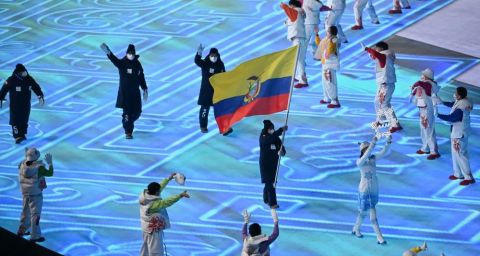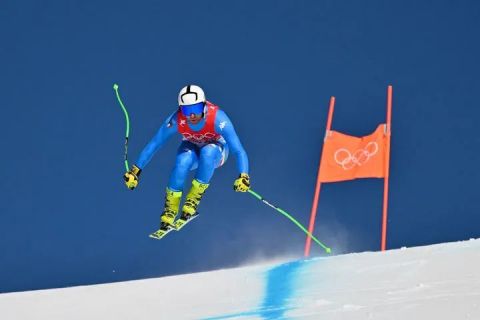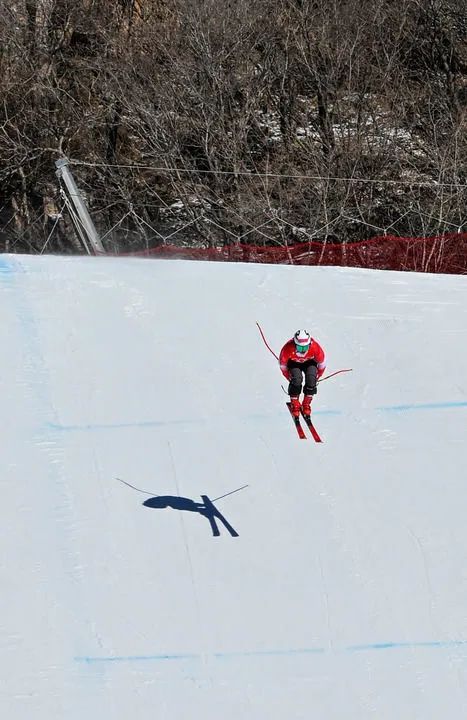Why do delegations with few people prefer alpine skiing? Is the threshold of this project low?
Haiti, Philippines, Ghana, Ecuador … … At the opening ceremony of the Beijing Winter Olympics on the evening of the 4th, people found that some countries or regions with hot impressions also sent delegations to participate. Most of these delegations have only one or two athletes, and almost all of them participate in alpine skiing. Some netizens laughed and said: Alpine skiing is the biggest "winner" of the opening ceremony.

On the evening of February 4th, the opening ceremony of the 24th Winter Olympic Games was held in Beijing National Stadium. Sarah Escobar (middle), the flag bearer of the Ecuadorian delegation and alpine skier, is the first female athlete in the history of Ecuador. Xinhua News Agency reporter Huang Zongzhi photo
The question is: Why do delegations with few people prefer alpine skiing? Does this project that sounds very imposing have a low threshold?
Snow sports with the largest number of registered people in Winter Olympics.
If we give an imprecise definition, alpine skiing is faster than the one who slides down the mountain. Without somersaults and obstacles, we just need to turn, and whoever gets to the end of the mountain first wins.
Kang Hua, the international referee of the International Skiing and Mountaineering Federation, said that skiing started as a mode of travel in snowy areas such as Northern Europe, China and Xinjiang, which was highly practical but hardly entertaining. At the end of the 19th century and the beginning of the 20th century, the center of skiing shifted from Northern Europe to the Alps, and modern alpine skiing technology was developed in the cross-country skiing prevailing in Northern Europe. Later, all the patterns and variants of snowboarding can be said to be branches of alpine skiing. The snowboarding that beginners learn in the snow field is also the basic skill of alpine skiing.
Therefore, in skiing, this project and cross-country skiing are well-deserved basic projects, but they are more interesting than cross-country skiing, and the mass base is easier to develop and consolidate.
In this Winter Olympics, there are 307 athletes registered successfully in alpine skiing, which is the largest number in snow sports and second only to ice hockey in 15 disciplines. Athletes cover more than 80 countries and regions.

On February 3rd, the first training of men’s downhill skiing in Beijing Winter Olympics was held at Yanqing National Alpine Ski Center in Beijing. The picture shows Italian player matteo Marsaglia in training. Xinhua News Agency reporter Chen Yizhen photo
This is largely due to the IOC’s intention to improve the participation and coverage of winter sports through this project, and its quota allocation rules are relatively loose. All delegations have two basic places, one man and one woman. As long as someone meets the requirements for Olympic points, delegations can get these two places. After the allocation of basic places, the rest will be produced from the world’s high-level athletes according to a series of rules.
Speed events are still high threshold.
Then the question comes again: If I come from a tropical country, the Winter Olympics is coming, I urgently find a ski resort to train hard, get points for participating in the global competition, and finally get the basic quota allocated by the International Olympic Committee, then can I participate in all the events?
Can’t. There is a high probability that you are only qualified for slalom and giant slalom. Gliding and super slalom are almost impossible.
In this Winter Olympics, there are 10 events for individual alpine skiing. Men and women are divided into downhill, super giant slalom, giant slalom, slalom and all-around. The all-around ratio is still downhill and slewing, so the four events, such as downhill, are the basis of the alpine skiing Winter Olympics.
Among them, downhill and super slalom are called "speed events", and slalom and slewing are called "technical events". The International Snow Federation has higher requirements for the venue of speed events, with long track and large drop. In the men’s downhill, which can be called the "Flying Man Wars" in the snow, the track gap should reach at least 800 meters and the length should be at least three kilometers. The top speed of athletes can even reach more than 140 kilometers per hour.
This leads to: first, it is difficult to find such a standard snow trail. The speed track of the National Alpine Ski Center in Yanqing Division is the first track in China that meets the standards of the Winter Olympics. In some areas where mountain resources are not abundant, even if it is cold enough, if the mountain is not high enough and the mountain is not big enough, there is no way. Second, people who are engaged in the project are difficult and dangerous, and have no training conditions, and they can’t meet the winter Olympic competition standards for speed projects in a short time.

On February 1st, the National Alpine Ski Center in Yanqing District of Beijing Winter Olympics held an all-factor drill. The picture shows a skater trying to skate on the track. Xinhua News Agency reporter Lian Zhenshe
"The International Snow Federation requires higher points for the speed events of the Winter Olympics than the technical events, just for safety." Didier Defogo, the designer of the men’s downhill track in this Winter Olympics and the champion of men’s downhill in 2010 Winter Olympics, said. Jamaican alpine skier Benjamin Alexander also said: "Even if there is an indoor ski resort, it is impossible to build a ski trail that can support downhill training."
In this Winter Olympics, there is only one athlete, and 15 delegations of this athlete participated in alpine skiing events. Without exception, they all participated in slalom and giant slalom. In addition, the experience of British player Dave Reading seems to prove that the flexibility of training in technical projects can be higher. He has been training in the indoor snow field, but at the age of 35, he still won his first men’s slalom World Cup sub-championship, and he is a strong contender for the medal in this Winter Olympics.